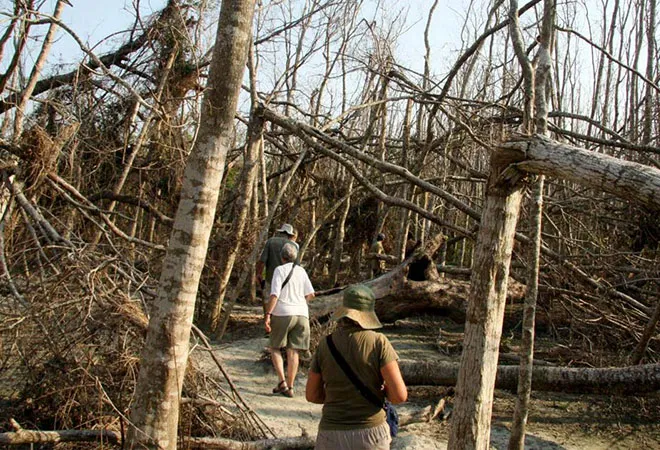Since 2001, every time a cyclone has made landfall in north east India, I am asked if the natural areas of the Sundarbans have been damaged, and in particular, if tigers have perished. In the aftermath of Cyclone Amphan too, it has been no different.
Until 2009, I would respond to these queries by saying that I do not know, or give vague answers. I am neither a meteorologist nor a wildlife specialist but by 2009, I had spent nearly a decade living and working in the Indian Sundarbans, and had some knowledge of the contiguous mangrove forest on the other side of the border through visits and interactions with local residents and experts. In May 2009, when Cyclone Aila hit the Sundarbans, I gained firsthand experience of the impact of the storm in human inhabited areas and the forest — and the confidence to comment on the situation.
Cyclones are so common in this part of the world that the term was coined in Calcutta. The term was introduced in the second edition of The Sailor’s Horn-book for the Law of the Storms, by Henry Piddington in 1848. By then, Piddington had been studying storms and publishing articles on the topic in the Journal of the Asiatic Society of Bengal for 10 years. In 1853, he advised against building Port Canning because of the vulnerability of the location to storms. He did not live to see the port being built. Port Canning was devastated in 1867 by a storm, and abandoned.
This was not the first enterprise to be abandoned in this part of the world due to storms. In 1811, the project of clearing Sagar Island was initiated under commercial terms. After initial hiccups, reclamation commenced in 1819 with construction of embankments, clearing of land, digging of freshwater tanks and settling cultivators. Five settlements made considerable progress by 1833 when a cyclone struck in May and almost all was lost. Subsequent storms struck in June 1842, October 1848, and again in June 1852, when settlers pretty much abandoned the island. To encourage settlers to stay back, all taxes were abolished until 1863. As the tax-free period expired, surveys were conducted afresh for tax assessment but another cyclone struck on 5 October 1864 and wrought great havoc. Yet another storm struck in November 1867 that reduced the cultivated area on the island to about 440 hectares. Due to these repeated calamities it was proposed that the island be made revenue free for ever, and fresh grants of land, free of revenue, were made during 1875-77 for six settlements.

Colonial literature has detailed accounts of cyclones in this part of the world but there is no mention of damage to the natural areas of the Sundarbans. Either such damages did not occur or were not taken into account. It is unlikely that the latter was the case because by 1865 the Forest Act was in place for protection of forest for timber. Forest related legislation in the subcontinent, in general, view forests as production units and it is therefore safe to assume that cyclones cause limited or insignificant damage to the natural areas of the Sundarbans. Cyclone Sidr that struck Bangladesh Sundarbans in November 2007 was an exception. The Extremely Severe Clyclonic Storm had attained peak one-minute sustained winds of 260 km/h and ripped off mangrove vegetation over vast tracts.
Until 24 May 2020, there have been no reports of animal casualties in the Indian Sundarbans. This is unsurprising because forest dwellers, including humans, are able to read environmental changes very well and are able to protect themselves. Think of the Sentinelese of Andaman who appeared unscathed by the Indian Ocean tsunami of December 2004. It is the non-indigenous and the exotic that suffer from natural hazards the most. The flora and fauna of the Sundarbans are indigenous whereas the people are not. Moreover, cyclone damage is caused by either the storm itself or the surge, or both. In case of the natural areas even if wind speed is relatively high there is little damage to vegetation, and mangroves moderate the surge. The natural islands are higher than the settled islands, thus the height of inundation is lower and for shorter duration since water moves unrestricted, unlike (with) embanked islands. The embanked islands are not only lower in elevation but are also saucer-shaped whereas the forested islands are like upturned saucers, draining water quickly.
Cyclonic events cause upwelling of nutrient rich water and fisher folk usually report higher catch after such events. I do not find reasons to be concerned about the ecological well being of the natural areas and their inhabitants due to cyclones unless future events are significantly more severe.
However, what is of concern is the decline of the terrestrial component of the ecosystem at an increasing rate, particularly on the Indian side. The Indian Sundarbans region is experiencing net land loss due to relative sea level rise and erosion. Modelling studies show that there will be a dramatic decline in suitable Bengal tiger habitats in the Sundarbans. Mangrove tigers are good swimmers but not aquatic animals. The same applies for mangroves too; mangrove vegetation can withstand diurnal inundation but are not aquatic plants.
Repeated storm strikes have shown that it is the human communities of the Sundarbans that suffer the most. The impact of Cyclone Amphan is no different. Rebuilding lives and livelihoods as they were prior to the cyclone is a missed opportunity because the gains of rebuilding are lost when the next cyclone strikes. While the interval between two such events is uncertain, the chances of a tropical depression forming in the Bay of Bengal and reaching severe cyclone stage is increasing, particularly during November, which accounts for highest number of intense cyclones in the region.
The missed opportunity is on account of conventional rebuilding that does not make the lives and livelihoods any less vulnerable since the risks emanating from the interaction between climate-related hazards (such as cyclones) with the vulnerability and exposure of human and natural systems remain unaddressed. Resilient rebuilding would involve rebuilding or creating new institutions, organisations, and systems to address, manage, and overcome adverse conditions now and in the future. This is expensive in terms time, effort and money, but social return on investment in the form of secured lives and livelihoods is also higher despite climate-related hazards, and returns accrue over the design life of the program, and beyond.
Resilient rebuilding could also address risks to the natural system. This would involve: 1. facilitating silt and freshwater flow into Indian Sundarbans to keep pace with relative sea level rise, 2. halting withdrawal of groundwater, and 3. making space for mangroves to migrate further inland. The last action can be undertaken only if humans relinquish the space they currently occupy. Conventionally thought, this might seem improbable but if a carefully phased out, participatory capacity building and empowerment approach is pursued for poverty alleviation and risk reduction, moving away from high-risk areas towards better opportunities may appear as the most attractive option for the younger section of the population. This approach would simultaneously improve prospects of human development and prevent avoidable loss of life and livelihood due to high intensity weather events such as Amphan, and partially reverse ecosystem degradation through mangrove regeneration on land relinquished by households moving to safer locations, and to a more secure future.
This commentary originally appeared in Firstpost.
The views expressed above belong to the author(s). ORF research and analyses now available on Telegram! Click here to access our curated content — blogs, longforms and interviews.





 PREV
PREV


